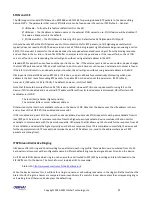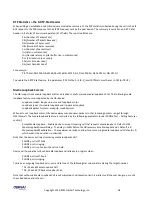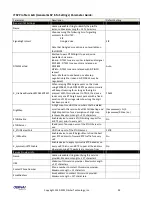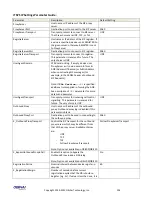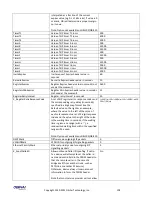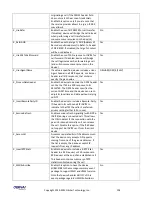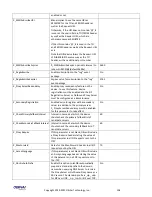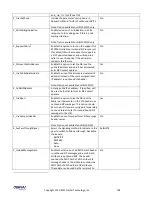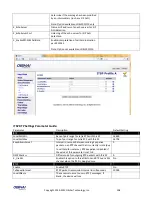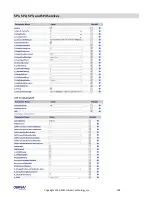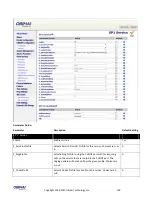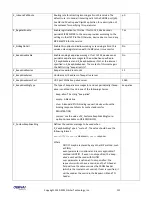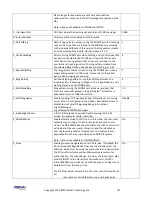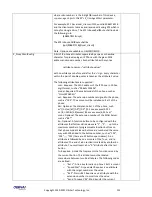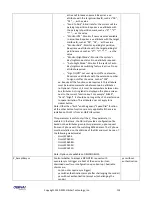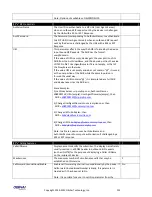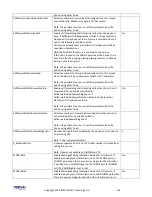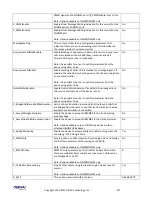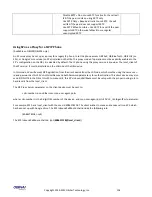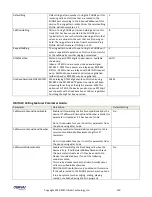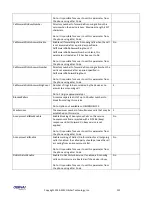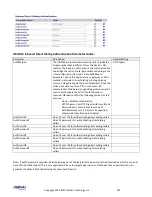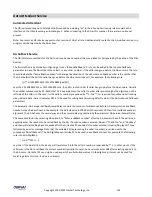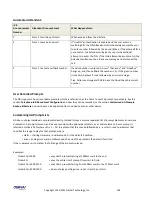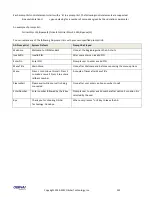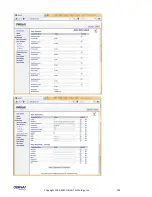
Copyright 2010-2013 Obihai Technology, Inc.
111
X_InboundCallRoute
Routing rule for directing incoming calls on this service. The
default rule is to send all incoming calls to the PHONE port (ph).
See
OBi Call Routing and Digit Map Section
for a description of
the syntaxes for specifying this parameter
ph
X_RegisterEnable
Enable registration for this line. If set to YES, device sends
periodic SIP REGISTER to the service provider according to the
settings in the ITSP Profile. Otherwise, device does not send any
SIP REGISTER for the service
Yes
X_NoRegNoCall
Enable this option to disallow making or receiving calls on this
service unless registeration with the SIP server is successful.
No
X_KeepAliveEnable
Enable sending keep alive message. If set to YES, device sends
periodic keep-alive messages to the destination specified in
X_KeepAliveServer and X_KeepAliveServerPort, at the interval
specified in X_KeepAliveExpires. The content of this message is
the ASCII string “keep-alive\r\n”
No
X_KeepAliveExpires
Keep alive period in seconds
15
X_KeepAliveServer
Hostname or IP address of keep alive server
X_KeepAliveServerPort
UDP port of the keep alive server
5060
X_KeepAliveMsgType
The type of keep alive messages to send out periodically if keep-
alive is enabled. It can be one of the following choices:
-
keep-alive: The string “keep-alive”
-
empty: A blank line
-
stun: A standard STUN binding request; device will use the
binding response to form its contact address for
REGISTRATION
-
custom: use the value of X_CustomeKeepAliveMsg (note:
option not available on OBi100/OBi110)
keep-alive
X_CustomKeepAliveMsg
Defines the custom message to be used when
X_KeepAliveMsgType is “custom”. The value should have the
following format:
mtd=NOTIFY;event=
<whatever>
;user=
<anyone>
Where
-
NOTIFY may be replaced by any other SIP method, such
as PING,
-
event parameter is optional and is only applicable if
method is NOTIFY. If event is not specified, the 'keep-
alive' event will be used with NOTIFY
-
user parameter is optional; if not specieifed, the
request-uri will not have a userid, and the TO header
field will use the same userid as the FROM header
(which is the local account userid). If user is specified, it
will be used as the userid in the Request-URI and TO
header.
Summary of Contents for OBi100
Page 54: ...Copyright 2010 2013 Obihai Technology Inc 54...
Page 55: ...Copyright 2010 2013 Obihai Technology Inc 55...
Page 58: ...Copyright 2010 2013 Obihai Technology Inc 58...
Page 75: ...Copyright 2010 2013 Obihai Technology Inc 75...
Page 100: ...Copyright 2010 2013 Obihai Technology Inc 100...
Page 109: ...Copyright 2010 2013 Obihai Technology Inc 109 SP1 SP2 SP3 and SP4 Services...
Page 126: ...Copyright 2010 2013 Obihai Technology Inc 126...
Page 135: ...Copyright 2010 2013 Obihai Technology Inc 135...
Page 140: ...Copyright 2010 2013 Obihai Technology Inc 140...
Page 157: ...Copyright 2010 2013 Obihai Technology Inc 157...
Page 158: ...Copyright 2010 2013 Obihai Technology Inc 158...
Page 159: ...Copyright 2010 2013 Obihai Technology Inc 159...
Page 174: ...Copyright 2010 2013 Obihai Technology Inc 174...
Page 185: ...Copyright 2010 2013 Obihai Technology Inc 185...

